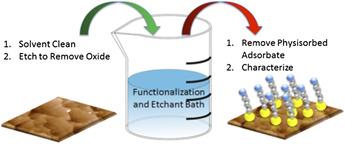Crossref Citations
This article has been cited by the following publications. This list is generated based on data provided by
Crossref.
Zhao, Jing
Madachik, Mark R.
O’Donnell, Kane M.
Moore, Gareth
Thomsen, L.
Warschkow, Oliver
Schofield, Steven R.
and
Teplyakov, Andrew
2016.
Adsorption and Dissociation of a Bicyclic Tertiary Diamine, Triethylenediamine, on a Si(100)-2 × 1 Surface.
The Journal of Physical Chemistry C,
Vol. 120,
Issue. 50,
p.
28672.
Snyder, Patrick J.
Kirste, Ronny
Collazo, Ramon
and
Ivanisevic, Albena
2016.
Nanoscale topography, semiconductor polarity and surface functionalization: additive and cooperative effects on PC12 cell behavior.
RSC Advances,
Vol. 6,
Issue. 100,
p.
97873.
Berg, Nora G
Franke, Alexander
Kirste, Ronny
Collazo, Ramon
and
Ivanisevic, Albena
2016.
Photoluminescence changes of III-Nitride lateral polarity structures after chemical functionalization.
Materials Research Express,
Vol. 3,
Issue. 12,
p.
125906.
Bermudez, V.M.
2017.
The fundamental surface science of wurtzite gallium nitride.
Surface Science Reports,
Vol. 72,
Issue. 4,
p.
147.
Snyder, Patrick J.
Kirste, Ronny
Collazo, Ramon
and
Ivanisevic, Albena
2017.
Persistent Photoconductivity, Nanoscale Topography, and Chemical Functionalization Can Collectively Influence the Behavior of PC12 Cells on Wide Bandgap Semiconductor Surfaces.
Small,
Vol. 13,
Issue. 24,
p.
1700481.
Gao, Fei
and
Teplyakov, Andrew V.
2017.
Challenges and opportunities in chemical functionalization of semiconductor surfaces.
Applied Surface Science,
Vol. 399,
Issue. ,
p.
375.
Meierhofer, Florian
Krieg, Linus
and
Voss, Tobias
2018.
GaN meets organic: technologies and devices based on gallium-nitride/organic hybrid structures.
Semiconductor Science and Technology,
Vol. 33,
Issue. 8,
p.
083001.
Snyder, Patrick J.
LaJeunesse, Dennis R.
Reddy, Pramod
Kirste, Ronny
Collazo, Ramon
and
Ivanisevic, Albena
2018.
Bioelectronics communication: encoding yeast regulatory responses using nanostructured gallium nitride thin films.
Nanoscale,
Vol. 10,
Issue. 24,
p.
11506.
Dryden, Daniel M.
Nikolic, Rebecca J.
and
Islam, M. Saif
2019.
Photogalvanic Etching of n-GaN for Three-Dimensional Electronics.
Journal of Electronic Materials,
Vol. 48,
Issue. 5,
p.
3345.
Adams, W. Taylor
and
Ivanisevic, Albena
2019.
Nanostructured Oxides Containing Ga: Materials with Unique Properties for Aqueous-Based Applications.
ACS Omega,
Vol. 4,
Issue. 4,
p.
6876.
Jeon, Seokmin
Kim, Minho
Doak, Peter W.
Atwater, Harry A.
and
Kim, Hyungjun
2019.
Probing Surface Chemistry at an Atomic Level: Decomposition of 1-Propanethiol on GaP(001) (2 × 4) Investigated by STM, XPS, and DFT.
The Journal of Physical Chemistry C,
Vol. 123,
Issue. 5,
p.
2964.
Kang, Jaewook
Mitsuhashi, Takuaki
Kuroda, Kensuke
and
Okido, Masazumi
2019.
Low-temperature synthesis of GaN film from aqueous solution by electrodeposition.
Journal of Applied Electrochemistry,
Vol. 49,
Issue. 9,
p.
871.
Sun, Yiming
Song, Weidong
Gao, Fangliang
Wang, Xingfu
Luo, Xingjun
Guo, Jiaqi
Zhang, Bolin
Shi, Jiang
Cheng, Chuan
Liu, Qing
and
Li, Shuti
2020.
In Situ Conformal Coating of Polyaniline on GaN Microwires for Ultrafast, Self-Driven Heterojunction Ultraviolet Photodetectors.
ACS Applied Materials & Interfaces,
Vol. 12,
Issue. 11,
p.
13473.
Gleco, Sara
Noussi, Theophraste
Jude, Akamu
Reddy, Pramod
Kirste, Ronny
Collazo, Ramón
LaJeunesse, Dennis
and
Ivanisevic, Albena
2020.
Oxidative Stress Transcriptional Responses of Escherichia coli at GaN Interfaces.
ACS Applied Bio Materials,
Vol. 3,
Issue. 12,
p.
9073.
Veerappan, Manimuthu
and
Wang, Fei
2020.
Dandelion Flower Like, APTES Functionalized Gallium Nitirde Microsphere for Fluorescence Detection of Bovine Serum Albumin Protein.
p.
342.
Guler, Seval Hale
Guler, Omer
and
Dikici, Burak
2021.
Handbook of Carbon Nanotubes.
p.
1.
Henning, Alex
Bartl, Johannes D.
Zeidler, Andreas
Qian, Simon
Bienek, Oliver
Jiang, Chang‐Ming
Paulus, Claudia
Rieger, Bernhard
Stutzmann, Martin
and
Sharp, Ian D.
2021.
Aluminum Oxide at the Monolayer Limit via Oxidant‐Free Plasma‐Assisted Atomic Layer Deposition on GaN.
Advanced Functional Materials,
Vol. 31,
Issue. 33,
Guler, Seval Hale
Guler, Omer
and
Dikici, Burak
2022.
Handbook of Carbon Nanotubes.
p.
659.
Weyher, J. L.
van Dorp, D. H.
Conard, T.
Nowak, G.
Levchenko, I.
and
Kelly, J. J.
2022.
Chemical Etching of GaN in KOH Solution: Role of Surface Polarity and Prior Photoetching.
The Journal of Physical Chemistry C,
Vol. 126,
Issue. 2,
p.
1115.
Guidat, Margot
Löw, Mario
Kölbach, Moritz
Kim, Jongmin
and
May, Matthias M.
2023.
Experimental and Computational Aspects of Electrochemical Reflection Anisotropy Spectroscopy: A Review.
ChemElectroChem,
Vol. 10,
Issue. 8,
